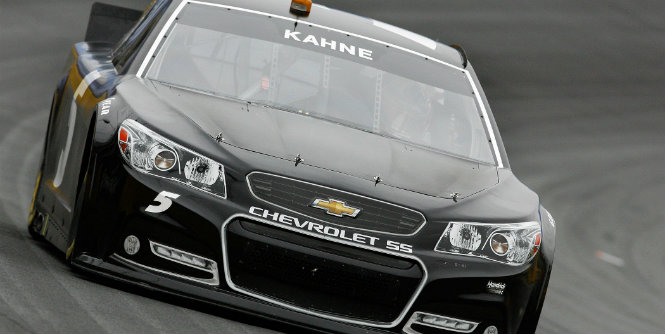The calendar has yet to change over to the new year, but the 2013 generation of Sprint Cup car has already claimed its first track record — albeit unofficially.
Kasey Kahne sped around Charlotte Motor Speedway at a brisk 193.771 mph on Wednesday morning, during the second and final day of testing for vehicles that will make their debut on NASCAR’s premier series at Daytona in February. That lap was faster than the track record owned Greg Biffle, who hit 193.708 in a pole-winning run here in October. Kahne’s lap didn’t count, of course — drivers can only set a track record during an event weekend — but it also provided a glimpse of how speedy the redesigned vehicles might be.
Wednesday’s test session carried one large caveat — temperatures in the 40s that made one of NASCAR’s fastest tracks even quicker. But even in more moderate conditions, the potential seems to exist for the 2013 cars to set new track records, and become known for their speed as well as their looks.
“I would say so,” Kahne said. “I was trying to think, if we were in the old car in race trim this time of year, if I could go as fast as I went this morning. I really don’t think I could. So I’m thinking there’s probably three or four tenths [of a second] there. That’s just a guess, but I would say three to four tenths that we’re running faster in this car than we would in that [one]. … I just think this car goes around the corner quicker.”
Kahne estimated that his top speed on the race track was probably in the neighborhood of 200 mph. “Maybe more,” he added. Steve Letarte, crew chief for Dale Earnhardt Jr., said there are several elements to the 2013 cars that could make them faster — differences in total downforce and distribution of downforce, reduced total weight, and increased rear camber that adds grip. But cold weather also adds grip and helps engines make more horsepower, particularly on a layout as temperature-sensitive as Charlotte.
“I think that’s basically a huge factor due to the weather,” Letarte said of the day’s top speed, which was 3 mph quicker than the fastest lap on Tuesday. “You see that here a lot. We come here in the day and practice at a 30 flat or 29.5 range, and yet we qualify at a 28 flat. I think weather is probably the primary contributor. … But I don’t think we’ll really know until we get to real race tracks on real race weekends.”
Wednesday’s session produced one accident — Denny Hamlin’s car broke an upper control arm and hit the wall seven laps into his morning run, scraping up the right side of the No. 11 car. His hauler was packed up before lunch. “Test over,” he wrote on Twitter. The day also came to an early end due to rain, so drivers didn’t get the opportunity to get on the track in a group as they had the previous afternoon.
In that limited time Tuesday, though, Kahne liked what he saw. “I felt really good in traffic,” he said. “I didn’t really have a problem passing the car in front of me. … I think just having a nice, balanced race car like we’ve had for the last day and a half has helped. I didn’t have a problem passing cars at all.”
The development of the 2013 cars marks a fundamentally different approach for Sprint Cup teams, which in the past received the nose, hood and roof from their respective manufacturers, and built the rest of the cars themselves. Now, with the cars bearing more manufacturer identity that brings them much more in line with their production-line brethren, “a huge majority of this car is a supplied part,” Letarte said. That means more communication with manufacturers, and a supply line that “gets complicated with this many race teams and the demand,” which added.
All of which explains why teams showed up to the Charlotte test with cars in different stages of development. Although the body rules are set, some outfits tested with one-piece fiberglass vehicles that won’t be raceable once things start for real in February, while others were more in line with what fans will see on the track next season. Letarte said the No. 88 used this week was all metal, and probably legal save for the hood, deck lid and some glass pieces. But “the substantial foundation of the body should be accurate,” he added, which is why the vehicle will probably be used as a backup car early in the year.
It’s all being done with the goal of adding brand identity and making the race cars look more like vehicles on the street, something Letarte’s 9-year-old son Tyler can already see. “At 9 years old, that’s really what it comes down to,” he said. “The cars we were racing didn’t look like anything you would see on the street. … If you’re in racing, you want to watch cool cars on the track. I think the simple fact is, in 2013 we have cooler cars.”
And if Wednesday is any indication, potentially faster ones, too.
“You’re going through the corners a lot faster than what we did before, because you’re in the gas a lot more,” Joey Logano said. “I think at certain tracks you will [break track records], and certain tracks you won’t. It’s interesting. … With it being cooler out today, we’re going even faster, so you take all of that with a grain of a salt. I think speeds will be up. I think there is definitely some possibility for track records being broke, but we have to kind of wait and see what the package is going to be when it’s all said and done here from NASCAR.”







